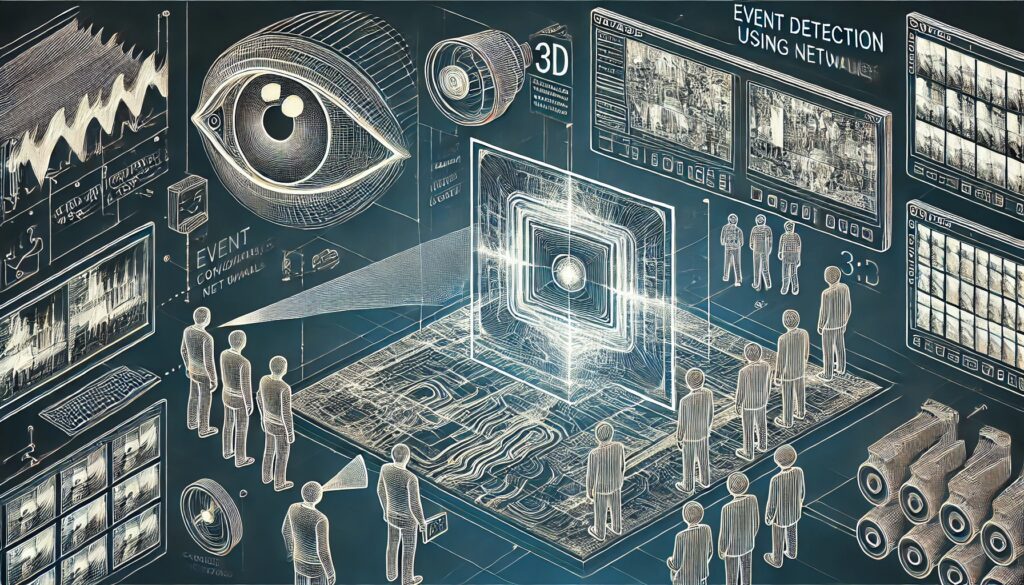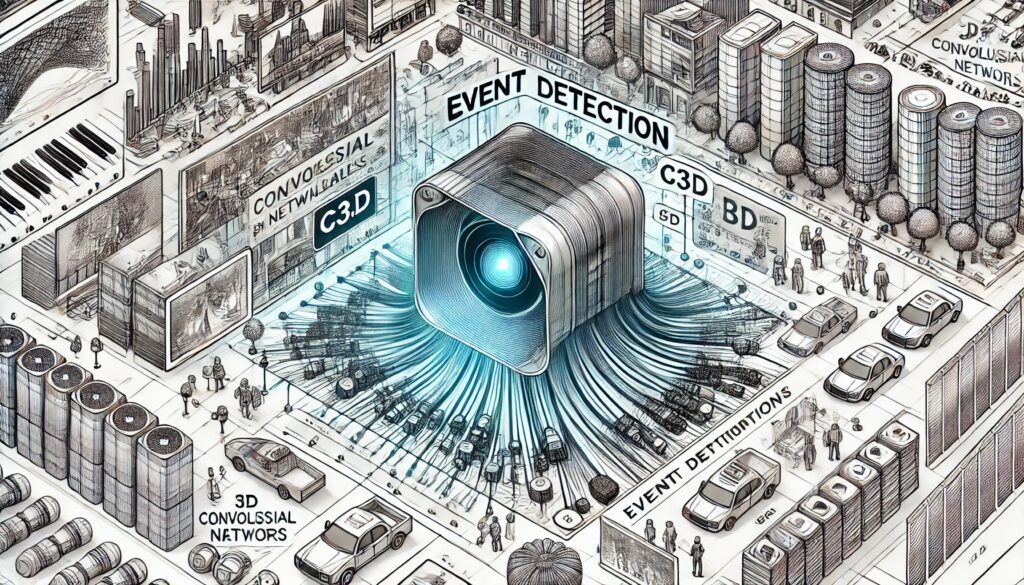
Boosting Public Safety with Real-Time Event Detection Using C3D Networks
Unveiling the Future of Surveillance: Event Detection with C3D Networks
In today’s rapidly evolving digital landscape, real-time event detection is becoming a cornerstone of public safety. By harnessing the power of Convolutional 3D networks (C3D), we can transform how we monitor and respond to incidents such as accidents, fights, and loitering. Let’s explore how this technology is reshaping surveillance and enhancing safety.
Objective Definition
Primary Goal: Our mission is to develop a robust system that can detect specific events in real-time. This system aims for high accuracy and low latency, ensuring immediate responses to critical incidents.
Secondary Goals: Beyond immediate detection, this technology aims to enhance public safety through timely interventions. It also seeks to generate actionable insights for law enforcement and security agencies, helping to analyze data and improve urban planning and security measures.
Data Collection
Source of Data: To build an effective system, data is sourced from various places:
- Public surveillance cameras in city streets, malls, schools, and other high-traffic areas.
- Private surveillance footage through collaboration with organizations.
- Social media platforms, ensuring compliance with privacy laws, provide additional video data.
Data Diversity: To ensure the model generalizes well, datasets must include diverse environments, weather conditions, lighting scenarios, and angles. Incorporating videos from different countries and cultures helps avoid biases.
Labeling: Accurate event labeling is crucial. Combining manual annotation with semi-automated tools, we ensure each event has precise timestamps and detailed descriptions.
Elevating Event Detection: Model Selection and Preprocessing
Model Selection
C3D Networks: To harness the power of C3D networks, we focus on their unparalleled ability to capture both spatial and temporal features. These networks excel in processing video data because they analyze sequences of frames rather than individual images. By pre-training the model on large action recognition datasets like Sports-1M, we leverage transfer learning to boost performance, saving time and resources in training.
Alternatives: While C3D networks are powerful, exploring alternative models can provide additional insights and improvements:
I3D (Inflated 3D ConvNet): I3D models offer enhanced performance on temporal features by inflating 2D convolutions into 3D, capturing more detailed motion information. This can be particularly useful for detecting intricate patterns in activities.
LSTM-Based Models: For sequential data analysis, LSTM (Long Short-Term Memory) networks are invaluable. They excel in recognizing patterns over extended durations, making them suitable for activities that unfold over longer periods, like loitering or prolonged altercations.
Hybrid Approaches: Combining 2D ConvNets with RNNs (Recurrent Neural Networks) provides a hybrid approach that captures both spatial and temporal dynamics efficiently. This combination can be especially effective in scenarios where both detailed spatial information and temporal continuity are crucial.
Preprocessing
Frame Extraction: Consistent frame extraction is the first step in preprocessing. Extracting frames at a rate of 24 frames per second maintains temporal coherence. This ensures the model receives a steady stream of data, capturing every critical moment. Frame skipping can be employed to manage computational load, balancing detail with efficiency.
Normalization: Normalizing pixel values to a range of [0, 1] or [-1, 1] standardizes the input data, crucial for consistent performance across various lighting conditions and environments. Histogram equalization further enhances this by improving contrast, making it easier for the model to discern features in low-light videos.
Data Augmentation: Diversifying the training data through data augmentation techniques ensures the model generalizes well to real-world scenarios. Techniques such as rotation, scaling, cropping, and adding noise help in creating a robust dataset. Additionally, temporal augmentation, like varying frame rates, simulates different recording conditions, making the model more resilient to variations in video quality and capture settings.
By integrating these advanced preprocessing steps, we set a strong foundation for the model to perform at its best, ensuring high accuracy and reliability in detecting critical events in real-time.

Enhancing Detection Accuracy with Feature Engineering and Model Training
Feature Engineering
Temporal Features: Capturing motion patterns is crucial for detecting dynamic events. One effective technique is using optical flow, which analyzes the motion of objects by tracking changes in pixel intensities over time. This helps in identifying movements associated with specific events, such as sudden accelerations in accidents or erratic movements in fights.
Spatial Features: Detecting objects and their interactions requires robust object detection models. Pretrained models like YOLO (You Only Look Once) and Faster R-CNN are excellent for this purpose. These models can identify and classify objects within each frame, providing critical context for the events being analyzed. By extracting features from each frame using 2D ConvNets, we can then feed these spatial features into the C3D network for comprehensive temporal analysis.
Combination: Using a hybrid approach that combines spatial and temporal features significantly enhances the model’s ability to detect complex events. This involves integrating the object detection capabilities of 2D ConvNets with the temporal analysis strength of C3D networks. Such a combination ensures that the system can understand both the static context and the dynamic progression of events.
Model Training
Training Pipeline: Setting up a robust training pipeline is essential for efficient model development. Frameworks like TensorFlow and PyTorch provide the necessary tools for building and training deep learning models. Implementing efficient data loaders is critical for handling large video datasets, ensuring that data is fed into the model seamlessly during training.
Loss Function: Choosing the right loss function is crucial for the model’s performance in multi-class classification tasks. Cross-entropy loss is commonly used for its effectiveness in differentiating between multiple classes. Additionally, considering weighted loss functions can help address class imbalance, ensuring that less frequent events are still detected accurately.
Optimization: Effective optimization techniques are key to training a high-performing model. Using optimizers like Adam or SGD (Stochastic Gradient Descent) with learning rate scheduling helps in achieving faster convergence and better performance. Implementing regularization techniques such as dropout and L2 regularization prevents overfitting, ensuring that the model generalizes well to new, unseen data.
By meticulously engineering features and setting up a robust training process, we can significantly enhance the accuracy and reliability of our real-time event detection system. This not only improves immediate response capabilities but also provides valuable insights for long-term security measures.
Advancing Real-Time Event Detection with Efficient Processing and Alerting
Real-time Processing
Inference Speed: Optimizing the model architecture is crucial for achieving a balance between accuracy and inference speed. Techniques such as model compression, including pruning and quantization, significantly reduce the computational load. These methods streamline the model by removing redundant parameters and reducing the precision of calculations, respectively, ensuring faster processing without compromising too much on accuracy.
Stream Processing: Implementing a robust streaming framework is essential for real-time video analysis. Tools like Apache Kafka and Apache Flink are ideal for this purpose, as they handle high-throughput data streams efficiently. Using sliding window techniques, the system can continuously analyze video segments, providing a seamless flow of information that captures ongoing events as they unfold.
Edge Computing: Deploying models on edge devices such as NVIDIA Jetson and Google Coral offers significant advantages for local processing. By performing computations closer to the data source, latency is greatly reduced, enabling quicker responses. Ensuring these devices have sufficient computational power and optimized software is critical for maintaining efficiency and reliability.
Detection and Alerting
Event Detection: Implementing robust logic to detect specific events based on model outputs and predefined thresholds is vital. Post-processing techniques help to filter out false positives, enhancing the overall reliability of the system. This ensures that alerts generated are accurate and actionable.
Alert System: Designing a multi-channel alert system ensures that notifications are sent out immediately through various channels like SMS, email, and mobile app notifications. This rapid communication is crucial for timely interventions. Integrating the alert system with existing emergency response systems automates the dispatch of authorities, streamlining the response process.
Actionable Insights: Providing detailed reports and visualizations of detected events, including the location, time, and severity, helps in making informed decisions. These insights are not only useful for immediate response but also for strategic planning. Offering recommendations based on detected patterns, such as increasing patrols in high-risk areas, enhances long-term security measures.
By integrating these advanced real-time processing and alerting techniques, the event detection system becomes a powerful tool for enhancing public safety. The combination of optimized inference, efficient stream processing, and proactive alerting ensures a comprehensive approach to managing and responding to critical events.

Ensuring System Integrity: Evaluation and Validation
Evaluation and Validation
Accuracy Metrics:
Evaluating the performance of the event detection model is crucial for ensuring its effectiveness. Key metrics include precision, recall, F1-score, and ROC-AUC. Precision measures the proportion of true positive detections out of all positive detections, ensuring the model’s specificity. Recall, on the other hand, measures the proportion of true positive detections out of all actual events, highlighting the model’s sensitivity. The F1-score combines both precision and recall into a single metric, providing a balanced measure of the model’s accuracy. Additionally, ROC-AUC (Receiver Operating Characteristic – Area Under Curve) offers insight into the model’s ability to distinguish between different classes, further validating its performance.
Conducting a confusion matrix analysis helps identify and address specific error types. This analysis provides a detailed breakdown of true positives, true negatives, false positives, and false negatives, enabling targeted improvements to enhance the model’s accuracy and reliability.
Real-world Testing:
To validate the robustness of the event detection system, extensive field tests are necessary. These tests should be performed in various environments, including urban areas, public transportation hubs, and indoor spaces like malls and schools. Real-world testing allows for the assessment of the system’s performance under different conditions, such as varying lighting, weather, and crowd densities.
Collecting feedback from field operators is essential for refining detection algorithms. Operators can provide practical insights on the system’s performance, helping to identify areas for improvement and ensuring the model adapts to real-world scenarios effectively.
Continuous Learning:
Implementing mechanisms for continuous learning ensures the event detection system remains up-to-date and effective. By learning from false positives, false negatives, and user feedback, the model can continuously improve its accuracy. Techniques like online learning or periodic model retraining are instrumental in adapting to new event types and evolving scenarios.
Online learning allows the model to update its parameters incrementally as new data becomes available, providing real-time adaptability. Periodic retraining, on the other hand, involves periodically updating the model with new datasets, ensuring it remains relevant and accurate over time.
Ethical and Privacy Considerations
Data Privacy: Ensuring compliance with privacy regulations such as GDPR and CCPA is paramount. This involves anonymizing data to protect individual identities and securing data storage to prevent unauthorized access. Implementing consent mechanisms for data collection in private areas further ensures that individuals are aware of and agree to their data being used.
Bias Mitigation: Conducting bias audits helps identify and mitigate biases in training data and model predictions. Using diverse datasets ensures fair representation across different demographics, reducing the risk of biased outcomes. This is crucial for maintaining the ethical integrity of the event detection system and ensuring it serves all communities equitably.
Transparency: Maintaining transparency about data usage, model decision-making processes, and event detection criteria builds trust with users. Providing users with access to their data and the ability to opt-out if desired ensures ethical use and respects individual privacy rights.
By rigorously evaluating the model’s performance, validating its robustness in real-world scenarios, and adhering to ethical and privacy considerations, we can ensure that the event detection system is not only effective but also trustworthy and fair. This comprehensive approach guarantees that the system meets the highest standards of integrity and reliability.

Scaling Up: Deployment and User Interface for Event Detection Systems
Deployment and Scalability
Cloud Integration: Leveraging cloud platforms such as AWS, Azure, and Google Cloud provides scalable storage and processing capabilities essential for handling large volumes of video data. These platforms support serverless architectures, enabling the system to dynamically manage workloads based on demand. Serverless computing ensures that resources are allocated efficiently, scaling up during peak times and down when demand is low, thus optimizing costs and performance.
Edge Deployment: Deploying lightweight versions of the model on edge devices is crucial for local processing, especially in remote or bandwidth-limited areas. Edge devices, such as NVIDIA Jetson or Google Coral, allow for real-time analysis and reduce the latency associated with data transmission to central servers. Ensuring seamless synchronization between edge devices and central servers is vital for maintaining consistency and accuracy across the system.
Scalability: Designing the system to handle multiple video feeds simultaneously requires robust load balancing mechanisms. Implementing horizontal scaling techniques allows the system to add more resources as needed, ensuring consistent performance even as the number of video feeds increases. This approach ensures that the system remains responsive and efficient, regardless of the scale of deployment.
User Interface
Dashboard: An intuitive dashboard is essential for effective monitoring and management of the event detection system. The dashboard should offer real-time views of detections, historical data, and overall system health. Providing customizable views and alerts for different user roles, such as security personnel and administrators, enhances usability and ensures that relevant information is easily accessible.
Visualization: Effective visualization tools are key to understanding detected events. Offering visual representations such as heatmaps, timelines, and geographical maps provides clear and actionable insights. Integrating with GIS systems allows for location-based analysis, helping to pinpoint areas with high incident rates and informing strategic decisions for resource deployment.
User Feedback: Incorporating mechanisms for user feedback enables continuous improvement of the event detection system. Users should be able to report on detection accuracy and system performance, providing valuable insights for refining algorithms. Using this feedback to update and enhance the model ensures that the system evolves and adapts to new challenges and requirements.
By focusing on scalable deployment and user-friendly interfaces, the event detection system can achieve wide-reaching impact, enhancing public safety and operational efficiency across various environments.
Building Strong Foundations: Collaboration and Future Enhancements
Collaboration and Partnerships
Stakeholders: Engaging with a diverse group of stakeholders is crucial for the success of any real-time event detection system. Law enforcement, security agencies, urban planners, and community organizations play vital roles in both the design and deployment phases. Involving stakeholders early ensures the system meets practical needs and addresses real-world challenges effectively. Their insights help tailor the system to specific requirements, enhancing its utility and acceptance.
Partnerships: Collaboration with technology providers is essential for accessing cutting-edge hardware and software solutions. These partnerships provide the necessary tools to build and maintain a state-of-the-art system. Additionally, partnering with academic institutions fosters research into advanced event detection techniques and model improvements. Academic collaborations can lead to innovative approaches and keep the system at the forefront of technological advancements.
Future Enhancements
Advanced Analytics: Integrating predictive analytics can significantly enhance the system’s capabilities. By analyzing historical data and trends, predictive models can forecast potential events, allowing for proactive measures. Machine learning algorithms can identify patterns and correlations that indicate increased risk, enabling early interventions and enhancing public safety.
Integration: Combining the event detection system with other surveillance technologies, such as drones and wearable cameras, provides comprehensive coverage and deeper insights. Developing APIs for integration with third-party applications and services extends the system’s functionality, creating a versatile platform for various security applications.
Adaptive Learning: Implementing adaptive learning techniques allows the model to dynamically adjust to new event types and evolving scenarios. Reinforcement learning can be used to improve detection accuracy and response effectiveness over time. These techniques ensure the system remains robust and relevant, adapting to changes and continuously improving its performance.
Conclusion
Real-time event detection systems using C3D networks represent a significant advancement in public safety technology. By focusing on robust model selection, meticulous preprocessing, and comprehensive feature engineering, these systems achieve high accuracy and reliability. Optimized real-time processing and efficient alerting mechanisms ensure immediate and effective responses to critical events.
Rigorous evaluation and validation processes maintain system integrity, while ethical and privacy considerations uphold user trust and compliance with regulations. Scalable deployment and intuitive user interfaces enhance usability and accessibility, making these systems valuable tools for diverse environments.
Collaboration with stakeholders and partnerships with technology providers and academic institutions drive innovation and ensure the system meets practical needs. Looking ahead, future enhancements in predictive analytics, integration, and adaptive learning will further elevate the capabilities of event detection systems, paving the way for a safer and more secure future.
Sources:
- Abnormal Activity Detection Using Deep Learning
- Learning Deep C3D Features For Soccer Video Event Detection
- A New 3D Convolutional Neural Network Framework for Multimedia Event Detection
- Analysis of Anomaly Detection in Surveillance Video: Recent Trends and Future Vision
- Neuro-Symbolic Integration
- Interpretability and Explainability in Machine Learning